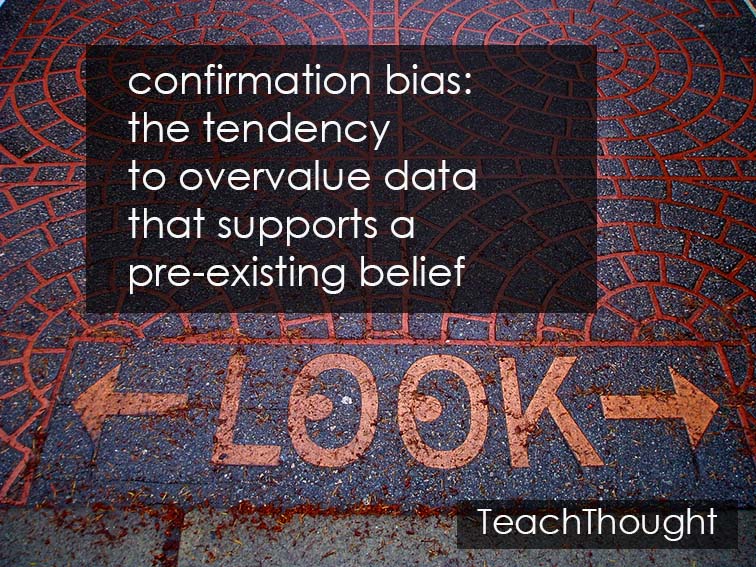
什么是确认偏见?简短概述
经过特里·希克(Terry Heick)
什么是确认偏见?
从广义上讲,确认偏见是人们高估支持自己信念的数据的趋势。
众多认知偏差, whether based on fear (e.g., ‘I’m going to lose my job’) or inaccurate and/or incomplete data (e.g., a stereotype), someone who falls victim to confirmation bias will form an opinion and then seek out and/or overvalue data that supports that opinion. In the former example of losing your job, because of worry over losing your job, you would begin to ‘notice’ things that seemed to support that theory.
也许您开始看到您的校长不会“访问您以前的频率”。您还注意到,学校已为开放的教学职位放置了一个分类的广告,似乎适合您目前填补的教学职位。最后,您已经“听到”该地区正在“做出一些更改”。因为所有这些都支持您最初的恐惧(您会失业),所以他们都会更加引起您的共鸣。它们令人难忘,令人震惊,而且似乎可信。
也可以看看3种思维方式:收敛,分歧和横向思维
什么是确认偏见?如何“发生”?
该模式是形成一个理论(通常是基于情感),并由数据支持,然后限制批判性思维和持续的分析,这当然是不合理的。相反,您查找适合您理论的数据。
通常,确认偏见有五个步骤:
1.形成理论(或“有意见”)
2.找到支持该意见的“数据”
3.努力收集越来越多的数据来真正“确认”您的理论(即您相信的)
4.确定最引人注目的数据类型,您最经常想说服您的理论(因为那是人们喜欢做的),然后收集,记忆,重新包装和完善和完善这些数据,以更整齐地符合您的理论
5.在理论上变得更加情绪化(即您的意见),因为您现在比以往任何时候都更加安全
6.继续打折并抹黑新的或更好的数据,因为这样您就必须重建您的信仰系统,向人们道歉,承认您错了,等等。
如何抵抗确认偏见
您如何保持确认偏见?不断地重新评估您所知道的,坚持最高质量的数据,并接受我们所有人的频率比正确的可能性更频繁的可能性。
粗糙地说,这种模式看起来像这样:
1.考虑所有数据,并知道如何将好数据与不良事实,意见,虚假陈述的事实与正确的文化事实等等等。
2.根据上述数据/数据源形成理论
3.对新的数据,想法,构造和观点开放,并根据需要对您的理论进行修订
4.向前迈进,使用数据来告知您的理论形成,而不是使用理论来告知您的数据。
概括
确认偏见是批判性思维的杀手。
相反的方法令人筋疲力尽。To constantly consider a broad set of evidence and data (historical patterns, existing trends, widespread indicators, alternative explanations, etc.) and then narrow it down to identify higher-quality data in order to form a ‘fluid’ conclusion that you then consistently revisit in light of ‘new’ data as it becomes available–data that wasn’t handpicked to support a theory but rather is fresh, valid, credible, and relevant–takes a lot of cognitive energy and thinking strategies and human determination, not to mention humility, which is why it’s not as common as it could be.
这里的一个沉默因素是认知失调的挑战 - 同时持有两种相互竞争的信念。这是不舒服的,因此,当考虑“什么是真实的”时,我们倾向于坚持一个并倾斜另一个,然后搜寻数据以证明我们是对的。这可能会导致一种自我实现的预言,从本质上讲,您会在其中存在偏见和不安全感。
确认偏见的定义;确认偏见确实杀死了思维。图像归因flickr用户dru
